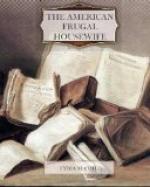Few people know how to keep the flavor of sweet-marjoram; the best of all herbs for broth and stuffing. It should be gathered in bud or blossom, and dried in a tin-kitchen at a moderate distance from the fire; when dry, it should be immediately rubbed, sifted, and corked up in a bottle carefully.
English-mallows steeped in milk is good for the dysentery.
* * * * *
CHEAP DYE-STUFFS.
A few general rules are necessary to be observed in coloring. The materials should be perfectly clean; soap should be rinsed out in soft water; the article should be entirely wetted, or it will spot; light colors should be steeped in brass, tin, or earthen; and if set at all, should be set with alum. Dark colors should be boiled in iron, and set with copperas. Too much copperas rots the thread.
The apothecaries and hatters keep a compound of vitriol and indigo, commonly called ‘blue composition.’ An ounce vial full may be bought for nine-pence. It colors a fine blue. It is an economical plan to use it for old silk linings, ribbons, &c. The original color should be boiled out, and the material thoroughly rinsed in soft water, so that no soap may remain in it; for soap ruins the dye. Twelve or sixteen drops of the blue composition, poured into a quart bowl full of warm soft water, stirred, (and strained, if any settlings are perceptible,) will color a great many articles. If you wish a deep blue, pour in more of the compound. Cotton must not be colored; the vitriol destroys it; if the material you wish to color has cotton threads in it, it will be ruined. After the things are thoroughly dried, they should be washed in cool suds, and dried again; this prevents any bad effects from the vitriol; if shut up from the air without being washed, there is danger of the texture being destroyed. If you wish to color green, have your cloth free as possible from the old color, clean, and rinsed, and, in the first place, color it a deep yellow. Fustic boiled in soft water makes the strongest and brightest yellow dye; but saffron, barberry bush, peach leaves, or onion skins, will answer pretty well. Next take a bowl full of strong yellow dye, and pour in a great spoonful or more of the blue composition. Stir it up well with a clean stick, and dip the articles you have already colored yellow into it, and they will take a lively grass green. This is a good plan for old bombazet curtains, dessert cloths, old flannel for covering a desk, &c; it is likewise a handsome color for ribbons.
Balm blossoms, steeped in water, color a pretty rose-color. This answers very well for the linings of children’s bonnets, for ribbons, &c. It fades in the course of one season; but it is very little trouble to recolor with it. It merely requires to be steeped and strained. Perhaps a small piece of alum might serve to set the color, in some degree. In earthen or tin.




